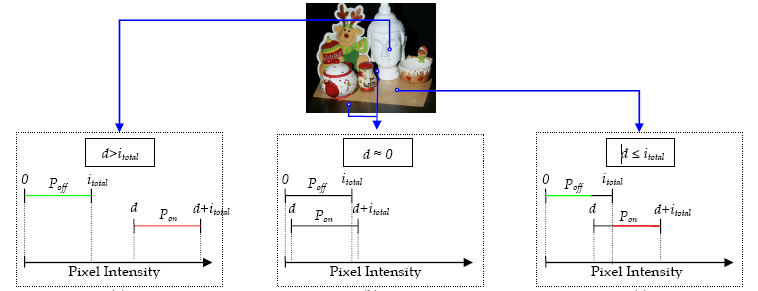| Summary |
| Modeling real-world scenes, beyond diffuse objects, plays an important role in computer graphics. One active approach is projecting binary patterns in order to obtain correspondence and reconstruct a densely sampled 3D model. In such structured-light systems, determining whether a pixel is directly illuminated by the projector is essential to decoding the patterns. When a scene has abundant indirect light, this process is especially difficult. We present a robust pixel classification algorithm for this purpose. Our method performs better than standard method due to the fact that it avoids gross errors during decoding process caused by strong interreflections. For the remaining uncertain pixels, we apply an iterative algorithm to reduce the inter-reflection within the scene. Thus, more points can be decoded and reconstructed after each iteration. Moreover, the iterative algorithm is carried out in an adaptive fashion for fast convergence. |
| Robust Pixel Classification |
| We introduce a robust, efficient, and easy to implement pixel classification algorithm for binary pattern structured light. Our method correctly establishes the lower and upper bounds of the possible intensity values of an illuminated pixel and of a non-illuminated pixel. Based on the two intervals, our method classifies a pixel by determining whether its intensity is within one interval and not in the other. Our method avoids gross errors during decoding process caused by strong interreflections. |
 |
| An Adaptive Algorithm for Modeling Scenes with Strong Inter-reflections |
| Our algorithm adapts the structured-light patterns according to the partially reconstructed scene geometry and reflectance property of the scene so as to reduce the amount of indirect illumination, while keeping the same amount of direct illumination for the remaining non-decoded pixels. Pixels are attempted to be corresponded using the aforementioned robust decoding algorithm. A projector-space subdivision is used whenever the number of additionally decoded pixels for an iteration is too small. Parallelism is automatically exploited during subdivision in order to simultaneously decode as many non-conflicting pixel subsets as possible and, consequently, reduce acquisition time. The end result is a significantly improved model of the scene including objects with strong inter-reflections at the cost of more photographs compared to a standard structured-light method. |
 |

|

